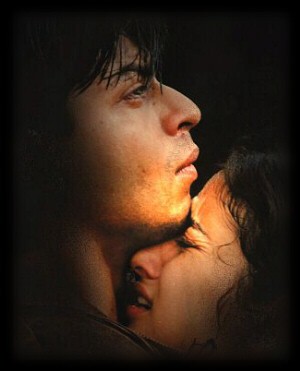

Value
For ‘Mani’
Mani Ratnam
Revisited
By Vishal Oberoi
Raindrops
fall into the glass teacup of a disillusioned Shah Rukh Khan, as he stands on
the railway platform watching a shawl-sheltered Manisha board a train to
disappearance. The wickedly cold, blustery weather congeals a moment that will
initiate a tale of love and crossfire. A moment captured on film. A moment from
Mani Ratnam’s Dil Se.
Mani
Ratnam. A name that needs no introduction. This 1955-born management consultant
from Madras ‘managed’ to stir the country’s attention as he steered Indian
cinema towards new horizons with his succinct and crisp movies. He was recently
in Dubai, and during the course of a debate which weighed the contribution of a
director to a film, vis-à-vis the star cast, he strongly supported the role of
a director. His standpoint is justified when one watches his avant garde
masterpieces, and beholds the charisma of his camera work. Every frame of his
film is a visual delicacy, something which cannot be completely assimilated by
the senses even after its passing, but it leaves its distinctive flavour in the
eyes. His unorthodox (albeit symphonic) artistry in the cinematic realm violates
every concept of tonal, focal and color continuity which film makers have made
conventional over the years.
 A
sharp influence of the West on his films is evident. Glimpses from Scorcese’s
‘The Godfather’ (1972) could be seen in Mani’s ‘Nayakan’ (1987),
where he meticulously recreated the slums of Dharavi for a more authentic
look. One can even cite the ‘ET’-like “bicycles across the sky” dream
sequence in ‘Anjali’ (1990). However that would be being
hypercritical, since Mani Ratnam’s films have a characteristic integrity of
their own, which can be solely associated with his works. ‘Geetanjali’ (1989)
was poetry to the eyes, as he dealt with the sensitive story of two lovers who
have only six months to live, set to the dreamy locales of Ooty.
Around the time-worn texture of a tale where a girl loses the man she
loves, and seeks him back, he wove ‘Roja’ (1992) and shaped a
‘patriotic love story’ that the nation can never forget. Romance and riots
both shared the limelight, and were key players in his thought-provoking
classic, ‘Bombay’ (1995). ‘Iruvar’ (1997) was a political
satire, loosely based on the life of M.G.Ramachandran, accompanied by sinuous
camerawork and the delightful musical score of A.R.Rehman. Each film, or rather
each frame of a Mani Ratnam movie, has something new to offer.
A
sharp influence of the West on his films is evident. Glimpses from Scorcese’s
‘The Godfather’ (1972) could be seen in Mani’s ‘Nayakan’ (1987),
where he meticulously recreated the slums of Dharavi for a more authentic
look. One can even cite the ‘ET’-like “bicycles across the sky” dream
sequence in ‘Anjali’ (1990). However that would be being
hypercritical, since Mani Ratnam’s films have a characteristic integrity of
their own, which can be solely associated with his works. ‘Geetanjali’ (1989)
was poetry to the eyes, as he dealt with the sensitive story of two lovers who
have only six months to live, set to the dreamy locales of Ooty.
Around the time-worn texture of a tale where a girl loses the man she
loves, and seeks him back, he wove ‘Roja’ (1992) and shaped a
‘patriotic love story’ that the nation can never forget. Romance and riots
both shared the limelight, and were key players in his thought-provoking
classic, ‘Bombay’ (1995). ‘Iruvar’ (1997) was a political
satire, loosely based on the life of M.G.Ramachandran, accompanied by sinuous
camerawork and the delightful musical score of A.R.Rehman. Each film, or rather
each frame of a Mani Ratnam movie, has something new to offer.
Ostensibly,
Mani Ratnam loves to explore territories where others fear to tread. ‘Alai
Payuthey’ (2000) could be referred to as an audacious sequel to every
conventional love story, because it examined the story of a couple who get
married, and then come to realize that marriage is not the ‘walk in the
clouds’ that it’s made out to be. The movie featured an eye-caressing dream
sequence that takes the viewer on a tour of the world of colour, with the screen
exploding with natural palettes and lenswork, as the lyrics flow.
Media-shy
by nature, Mani Ratnam projects a unique humility in his films. His films never
boast of their merit, and one could hardly expect to find the usual, unnecessary
clichés like “running around trees” song & dance routines or
astronomical star casts, in them. The subtle approach, the technical brilliance
and the genuine creative passion of the director in Mani Ratnam, together evolve
to create “reel” magic.
His
movies are an experience of their own. He’s come a long way from ‘Mauna
Raagam’ (1986) to his latest hit, ‘Kannathil Mutthamitaal’
(2002). He has been called “India’s answer to Spielberg” by his large cult
of die-hard fans, which include several members of the ‘MTV’ generation, who
have made a fashion statement out of having watched a Mani Ratnam film.
According to ‘them’, if you haven’t seen his latest ‘flick’, you’re
passé. Without a doubt, Mani is ‘in’, and he’s here to stay.